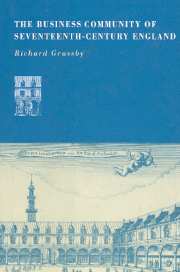Book contents
- Frontmatter
- Contents
- List of figures
- List of tables
- Preface
- List of abbreviations
- Explanatory notes
- Introduction: Questions and sources
- Part 1 Business as a career
- Part 2 Paths to fortune
- Part 3 Life styles
- 9 Religion and ethics
- 10 Family structure
- 11 Consumption and leisure
- 12 A symbiotic culture
- Conclusion: Private enterprise in a pre-industrial economy
- Bibliography
- Index
10 - Family structure
Published online by Cambridge University Press: 02 December 2009
- Frontmatter
- Contents
- List of figures
- List of tables
- Preface
- List of abbreviations
- Explanatory notes
- Introduction: Questions and sources
- Part 1 Business as a career
- Part 2 Paths to fortune
- Part 3 Life styles
- 9 Religion and ethics
- 10 Family structure
- 11 Consumption and leisure
- 12 A symbiotic culture
- Conclusion: Private enterprise in a pre-industrial economy
- Bibliography
- Index
Summary
The households of businessmen served as units of both production and consumption; the family was their principal instrument for protecting and transferring property and for social advancement. Some historians have argued that patriarchy and lineage were challenged during the seventeenth century by a new ideal of the family based on the nuclear household and more closely geared to the needs of a capitalist society. It is alleged that individualism redefined relationships between husbands and wives, between parents and children and between kin. The ‘bourgeois’ family is contrasted with the ‘aristocratic’ family and credited with different attitudes towards domesticity and childhood, with greater affection and less regimentation. Protestantism is assumed to have sacralized collective egoism and property in the family and de-emphasized the community, to have transformed tribal brotherhood into universal otherhood.
The concept of the ‘bourgeois’ family is a preconceived model. It rests in part on legal formulations, but has primarily been abstracted from Protestant sermons and homiletic and didactic tracts. In fact, the Reformation did not usher in drastic change and men of all religious denominations and social backgrounds agreed on the fundamental principles of the family, many of which derived from the Pauline Epistles. The ‘Family Instructors’ were aimed as much at the gentry as the merchants. The advice literature was interested in defending and promoting an ideal and sought to reform an institution which had proved inadequate; the numerous works can be read either as complaint or as exhortation, but their meaning is often ambiguous and they cannot be assumed to describe actual practice. The catechisms did, however, spread commonplace ideas and convey the assumptions and values which underlay family organization and justified everyday practice.
- Type
- Chapter
- Information
- The Business Community of Seventeenth-Century England , pp. 302 - 333Publisher: Cambridge University PressPrint publication year: 1995



